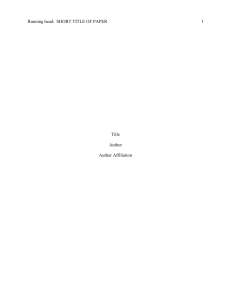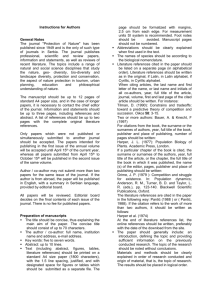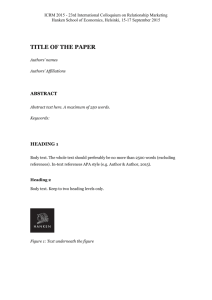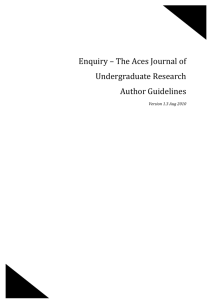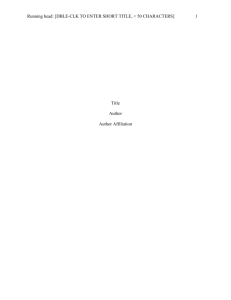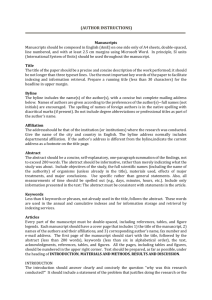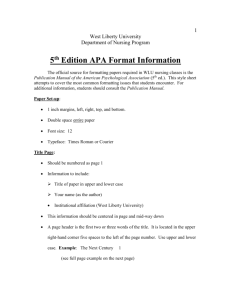Headings
advertisement
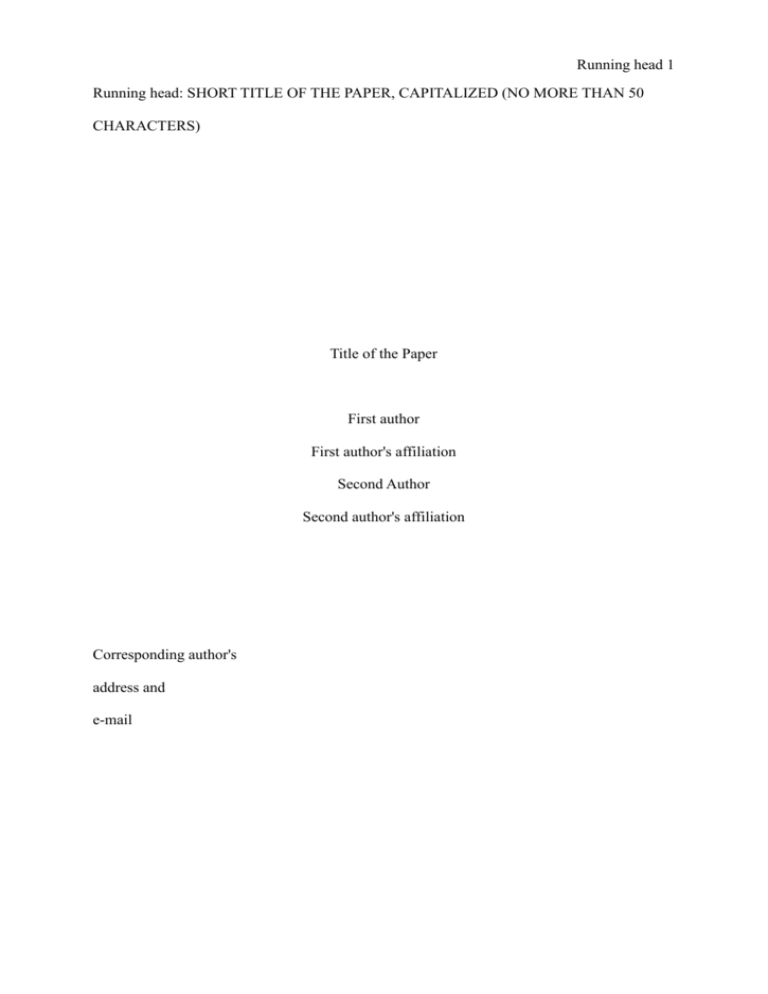
Running head 1 Running head: SHORT TITLE OF THE PAPER, CAPITALIZED (NO MORE THAN 50 CHARACTERS) Title of the Paper First author First author's affiliation Second Author Second author's affiliation Corresponding author's address and e-mail Running head 2 Abstract Your abstract should be one paragraph (not indented) and should not exceed 120 words. It is a summary of the most important elements of your paper. The abstract should not contain citations unless the works cited are of very high importance to the text. Abstract is placed on separate page. Keywords: separate; keywords; with semicolons Running head 3 Title of the Paper Again Introduction The text should be formatted according to latest APA Style guidelines, with 2.5 centimeters top, bottom, left, and right margins. A4 paper size is required. Acceptable file formats are: LaTeX file (tex), Microsoft Word document (doc, docx), OpenDocument text (odt), Portable document format (pdf), and Rich text format (rtf). Empirical papers should consist of four parts: (a) introduction containing theoretical background of the research and derivation of hypotheses, (b) detailed description of procedure, (c) description of results with statistical analysis, and (d) discussion of the results. The active voice, rather than passive voice, should be used in your writing. Headings Use headings and subheadings to organize the sections of your paper. The first heading level should be formatted with initial caps, bold font, and centered on the page. Do not start a new page for each heading. Second Level Heading Second level heading should be formatted with italics and are aligned flush left. Third Level Heading Third level heading should be formatted with italics, indented, and aligned flush left. Text Formatting Times New Roman or Courier font in 12 point; double-spaced; aligned flush left; and paragraphs indented 5-7 spaces should be used. The page number should appear on the right side of heading of each page, excluding the figures pages. Paragraph should contain more than one sentence and should not be longer than one page. Footnotes should be numbered continuously with Arabic numbers1. Running head 4 Ordered Lists 1. Two types of ordered lists are possible. 2. First contains of separate paragraphs containing at least one sentence. 3. Second contains of inline placed points which are (a) separate by down-case letters, and (b) may be parts of the same sentence. Citations Source material should be documented in the body of the paper by citing the authors and dates of the sources. The full source citation should appear in the list of references that follows the body of the paper. When the names of the authors of a source are part of the formal structure of the sentence, the year of the publication appears in parenthesis following the identification of the authors, for example: Braver, Gray, & Burgess (2007) provide some information concerning working memory capacity. When the authors of a source are not part of the formal structure of the sentence, both the authors and years of publication appear in parentheses, separated by semicolons, for example: Specific interference effect was observed (Gratton, Coles, & Donchin, 1992). When a source that has one or two authors is cited all author are included in the reference. When a source that has three, four, or five authors is cited, all authors are included the first time the source is cited. When that source is cited again, the first author’s surname and “et al.” are used. When source has more than five authors, the first author’s surname and “et al.” are used always. When source has been written in another language than English it should be cited in the same way as English-language source, but in reference the translated title should be provided in brackets (e.g., Nęcka, 2012). For internet sources (unless they are journal articles, books, or articles in collections) URL address and access time should be provided (e.g., Wikipedia, 2013). Running head 5 When a direct quotation is used, always include the author, year, and page number as part of the citation. A quotation of fewer than 40 words should be enclosed in double quotation marks and should be incorporated into the formal structure of the sentence. For example: Gratton et al. (1992, p.1) states: “If the choice of the processing level used to activate response is strategic […] , then it is possible that the extent to which noise information is processed together with target information may vary […]”. A quote of 40 or more but less than 500 words should appear (without quotes) in block format with each line indented five spaces from the left margin. For example: Sutton & Barto (1998, pp. 52-53) claim that: This framework is abstract and very flexible, allowing it be applied to many different problems in many different ways. For example, the time steps need not refer to fixed intervals of real time; they can refer to arbitrary successive stages of decision making and acting. The actions can be low-level controls such as the voltages applied to the motors of a robot arm, or high-level decisions such as whether or not to have lunch or to go to graduate school. Similarly, the states can take a wide variety of forms. They can be completely determined by low-level sensations, such as direct sensor readings, or they can be more high-level and abstract, such as symbolic descriptions of objects in a room. For more specific instruction concerning citation see latest edition of Publication Manual of the American Psychological Association. Tables, Figures and Formulas Tables Tables should contain information which can not be clearly presented in text. Tables should be placed in section at the end of manuscript, each table on separate page. Every table should be described in text. Please specific table placement in following way: Running head 6 -------------------------------------------------Please insert table 1 around here. -------------------------------------------------Each column of table should have a header. Only main horizontal lines should be visible. For example see Table 1. Figures Figures should depict information which can not be clearly presented in text or tables. Figures should be either vector or high resolution raster images. Only black-and-white figures are possible. Figures and captions should be placed in corresponding sections at the end of manuscript. Every figure should be described in text. Figure 1 presents exemplary image. Please specific figure placement in following way: -------------------------------------------------Please insert figure 1 around here. -------------------------------------------------Formulas Simple formulas, like e = mc2, can be contained in paragraph inline. Complex formulas should be placed in separate lines and numbered if referenced in text. If complex formulas are to be included, please use LaTeX format.(More detailed instructions can be found in LaTeX template). Running head 7 References Braver, T.S., Gray, J.R., & Burgess, G.C. (2007). Explaining the many varieties of working memory variation: Dual mechanisms of cognitive control. In A.R.A. Conway, C. Jarrold, M.J. Kane, A. Miyake, & J.N. Towse, Variation in working memory (pp. 76108). Oxford: Oxford University Press. Gratton, G., Coles, M.G.H., & Donchin, E. (1992). Optimizing the use of information: Strategic control of activation of responses. Journal of Experimental Psychology: General, 121(4), 480–506. Nęcka, E. (2012). Twórczość jako zmiana pojęciowa. [Creativity as a conceptual change]. In J. Bremer & A. Chuderski (Eds.), Pojęcia (pp. 319-329). Kraków: TAiWPN Universitas. Sutton, R.S., & Barto, A.G. (1998). Reinforcement Learning: An Introduction. Cambridge, MA: MIT Press. Wikipedia. (2013). Category theory. Retrieved from https://en.wikipedia.org/wiki/Category_theory (Online; accessed 19-April-2013) Running head 8 Appendix Appendix A Each Appendix should appear on its own page. Running head 9 Author Note Author note should be placed on separate page. Running head 10 Footnotes 1 All footnotes are placed in separate section starting with new page. Running head 11 Table 1 Type the table text here in italics; start a new page for each table; do not end caption with full stop Rule U A U' – low control U' – high control “Trained” 1 .2 .85 .53 “Target” .6 .1 .6 .6 “Others” .1 .1 .08 .05 Note: Some additional information can be provided under the table (e.g., significance levels indications). Running head 12 Figure Captions Figure 1. Caption of a figure should end with full stop.

